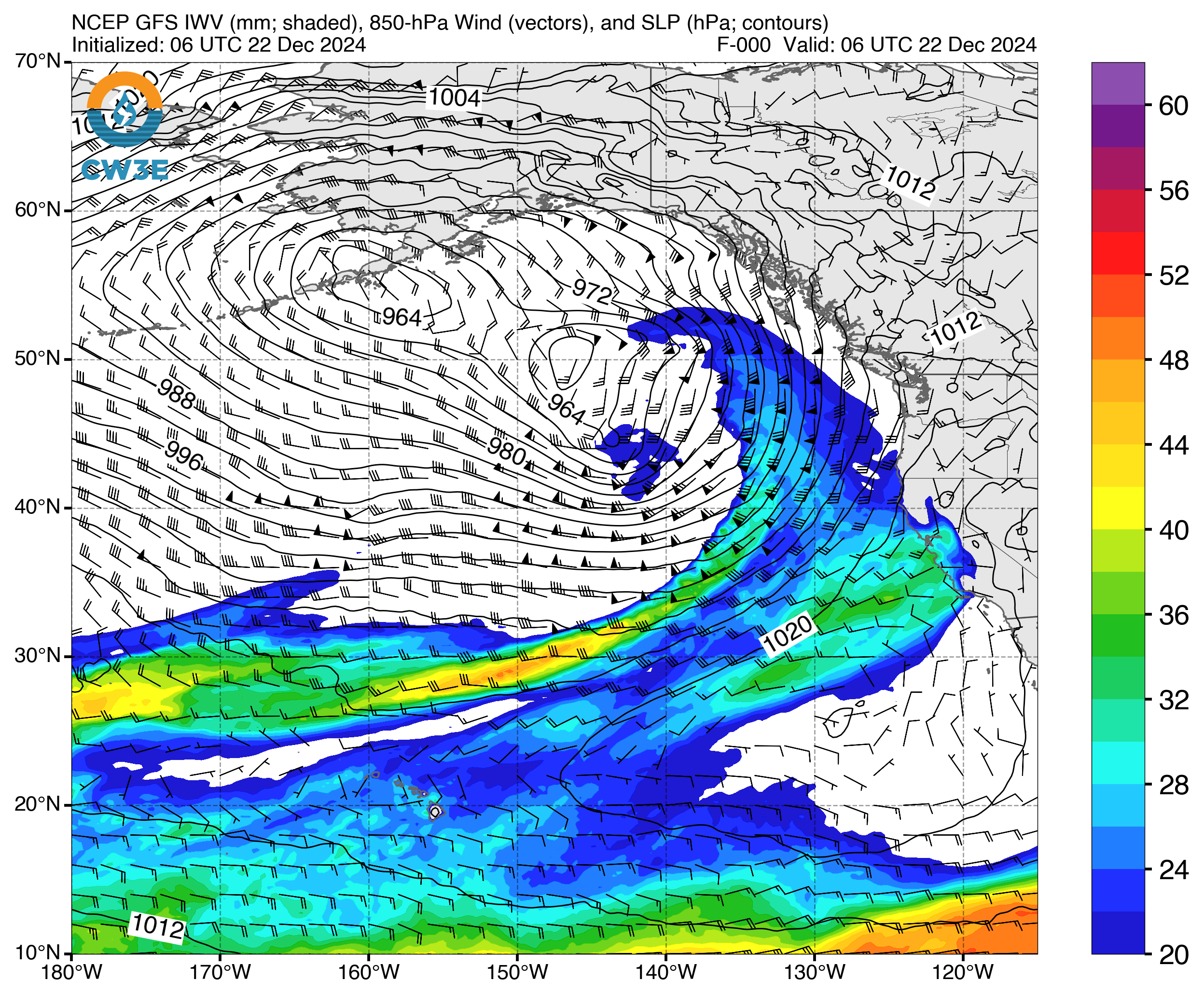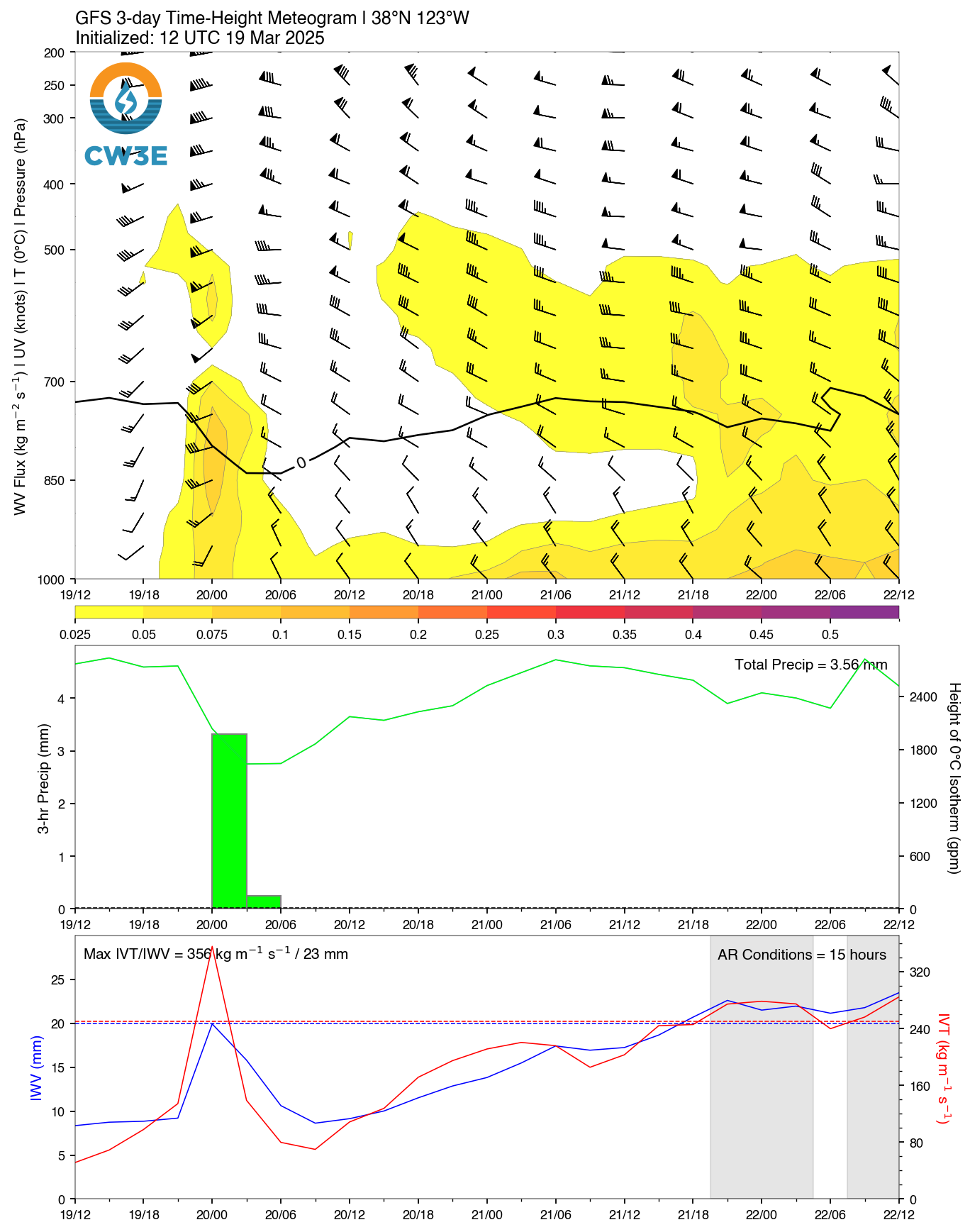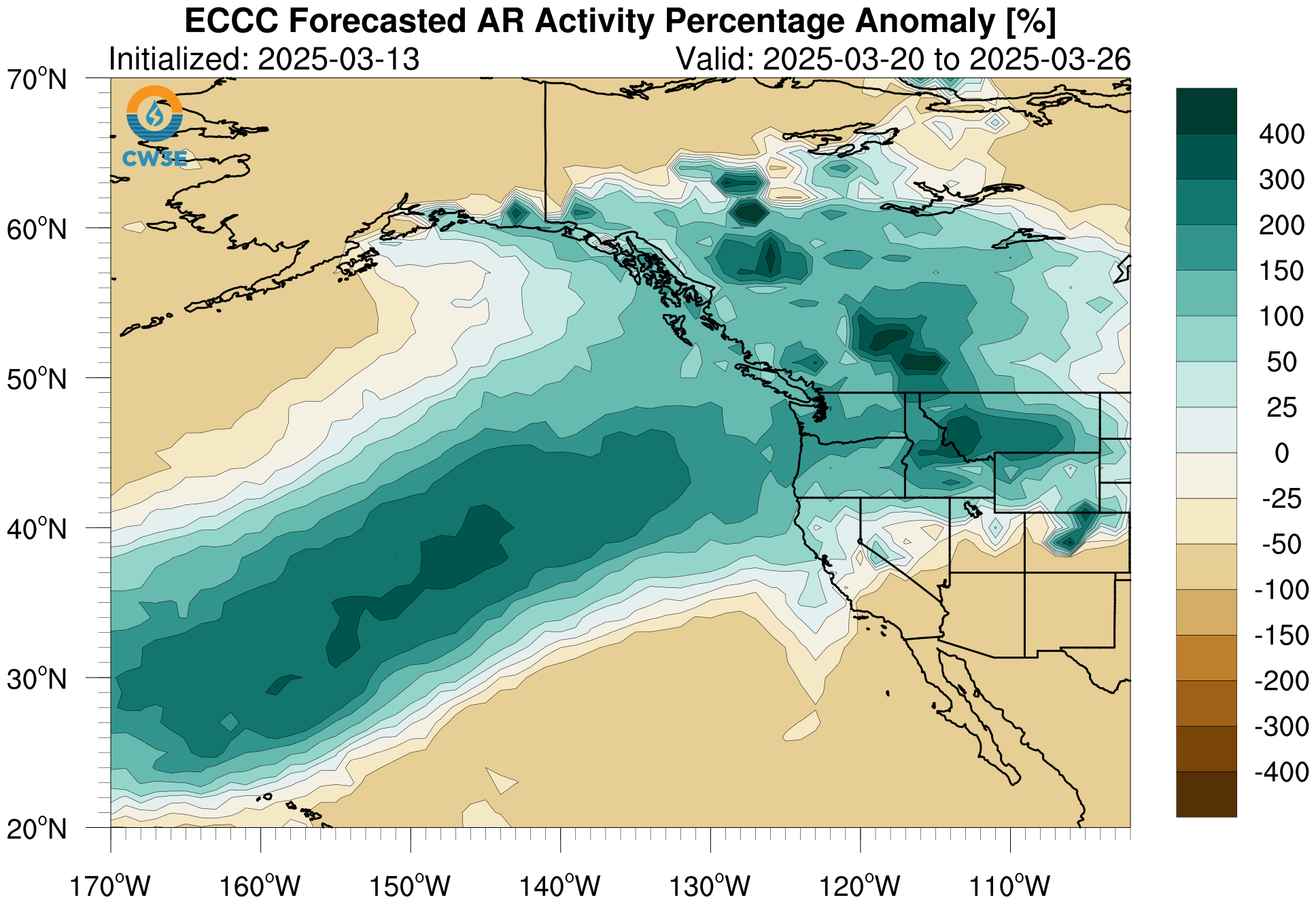Atmospheric River Forecast Products
The products are provided “as is” and are intended for research purposes only (disclaimer).
This page contains graphics designed to forecast the presence and strength of Atmospheric Rivers using data from the NCEP Global Forecast System (GFS), Global Ensemble Forecast System (GEFS – v12) and the European Centre for Medium-Range Weather Forecasts (ECMWF) models. For more information on ARs visit the AR FAQs or watch this informational video about ARs.
Deterministic Models: | IWV | IVT | Time-Integrated IVT | Meteograms | Cross Sections |
Ensemble Models: | Landfall Tool | IVT Plume Diagrams | AR Scale | Thumbnails | IVT Probability | Subseasonal Outlooks |
West-WRF: | Integrated Water Vapor | Integrated Vapor Transport |
Interactive Maps: | California Observations | AR Analyses and Forecasts | Watershed Precipitation Forecasts | Watershed Freezing Level Forecasts | Subseasonal and Seasonal Forecasts |
Deterministic Model Forecasts
IWV, IVT, and Time-Integrated IVT Click on an image to see forecasts out to 180 hours from the GFS, ECMWF, and NAM
 |
 |
 |
 |
 |
 |
|
 |
 |
 |
 |
 |
 |
|
 |
 |
 |
Integrated Water Vapor Transport (IVT) and Relative Humidity GFS Meteograms
These meteograms illustrate the forecasted conditions over a given locations for the 3 or 7-day forecast period from the GFS. The top panel includes water vapor flux (kg m-2s-1) or relative humidity (%) shaded with the 0°C isotherm contour and wind barbs(m/s), gray shading indicates location elevation. The middle plot illustrates the 3-hour precipitation represented by the bars, total 72-hour precipitation, height of the 0oC isotherm, and location elevation. When the freezing level is below the location elevation, line and bars are blue representing the likelihood of snow and when the freezing level is above the location elevation line and bars are green representing the likelihood of rain. The bottom plot illustrates the IWV and IVT, as well as the presence of AR conditions shaded in gray. The yellow dot on the map indicates the location of the current plot. Click here to view Alaskan domain
Select type of meteogram, latitude and longitude to generate plot. Click image to open in new tab.
 |
 |
Integrated Water Vapor Transport (IVT) Cross Sections
These cross sections illustrate the forecasted conditions along a longitudinal line from 25-65°N for the given forecast time from the GFS or ECMWF deterministic model. The top panel shows water vapor flux (kg m-2s-1, shaded), the 0°C isotherm (contour), and wind barbs (m/s) and the bottom panel illustrates the IWV and IVT. Black shading in the top panel represents terrain. The dashed lines on the bottom panel illustrate thresholds for AR conditions. The map on the left shows the location of the cross section as well as the IVT (kg m-1s-1) at the forecast time. Gray shading indicates the presence of AR conditions (IVT >250 kg m-1s-1 and IWV >20 mm). Select the model, longitude, and forecast lead time from the menus to see the cross section and click the image to open in a new window.
Select Longitude and Forecast Hour to generate plot
West Weather Research and Forecasting (West-WRF) Model
Integrated Water Vapor (IWV) Click on an image to see forecasts out to 240 hours from the West-WRF
 |
 |
Integrated Water Vapor Transport (IVT) Click on an image to see forecasts out to 240 hours from the West-WRF
 |
 |
Ensemble Forecast Systems
CW3E AR Landfall Tool
The probability CW3E AR Landfall Tool displays the likelihood and timing of AR conditions at each point on the map in a line along the U.S. West Coast or inland derived from the NCEP GEFS model over the next 16 days. The probability of AR conditions represents the number of ensemble members that predict IVT to be greater than the chosen threshold at the given location and time. To see how each forecast type has changed over the previous seven days click on dProp/dT.
Select variable or threshold to be displayed, location, and forecast length to generate plot, click image to open in a new tab.
|
dProg/dT |

West Coast IVT Magnitude Plume Diagrams
The plume diagrams below represent the integrated water vapor transport (IVT) magnitude forecast from each of the GEFS ensemble models (thin gray lines), the unperturbed GEFS control forecast (black line), the ensemble mean (green line), and plus or minus one standard deviation from the ensemble mean (red line (+), blue line (-), and gray shading). The dot on the map indicates the location of the current plot.
Select model, forecast length of plot, and location to generate plot. Click image to open in new tab.
 |
 |
Note initialization times may differ between models on individual model plots, all initialization times are the same on combined plots.
AR Scale Forecast Products
Forecast products based on the AR Scale developed in Ralph et al. (2019). Click on one of the images below to see the full suite of products for the AR Scale. This page includes products produced using the NCEP Global Forecast System (GFS), Global Ensemble Forecast System (GEFS), and the European Centre for Medium-Range Weather Forecasts (ECMWF) models.
 |
 |
 |
IVT Ensemble Probability Plots
Plot descriptions: Left: Probability of IVT exceeding 250 kg m-1 s-1 based on the 30 members of the Global Ensemble Forecast System (GEFS) and ensemble mean IVT vectors. Right: GEFS ensemble member 250 kg m-1 s-1 contours (thin lines) and ensemble mean (thick blue line).
Select model, forecast hour, threshold, and domain to generate plot. Click image to open in new tab.
 |
 |
Note initialization times may differ between models.
IVT Thumbnail Ensemble Plots
Select model, forecast hour and domain to generate plot. Click image to open in new tab.

The above images display the 30 members of the NCEP Global Ensemble Forecast System (GEFS); each thumbnail shows IVT (kg m-1 s-1) magnitude shaded according to scale and IVT vectors.
Subseasonal Outlooks (Weeks 1-3)
Dynamical Model Atmospheric River Activity Forecasts
A multi-model experimental forecast for AR activity (defined as the # of AR days per week) at week-2, 3, and 4 lead time is shown below for the NCEP, ECMWF, ECCC, and NASA GMAO dynamical models.
Top left: Forecasted number of AR days per week. Top right: Climatological values of AR activity in each model’s hindcast record for the corresponding lead time verification period. Bottom row: Departure from normal of the AR activity forecast (top left minus to right) shown in AR days per week (bottom left) and percentage anomaly (bottom right). Areas of green (brown) represent higher (lower) than average AR activity predicted during the selected week. Black dots indicate regions of high ensemble agreement, where at least 75% of members share the same anomaly sign. The hindcast skill assessments associated with these dynamical model hindcast systems are described in both DeFlorio et al. 2019b and Zhang et al. 2023.
NOTE: models will not always be initialized on the same day. Please check the initialization date in the title of the plots.
 |
 |
 |
 |
Interactive Maps
The interactive maps pages take advantage of “web mapping services”, GIS-based coding/thinking, and interactive technologies in order to provide dynamic weather analysis and forecast graphics in support of the CW3E mission. The pages on this website provide weather analysis and forecast data on a range of spatial and geographic scales from National and West-Coast overviews to watershed-based and atmospheric river-related products.
 |
 |
 |
 |
 |

